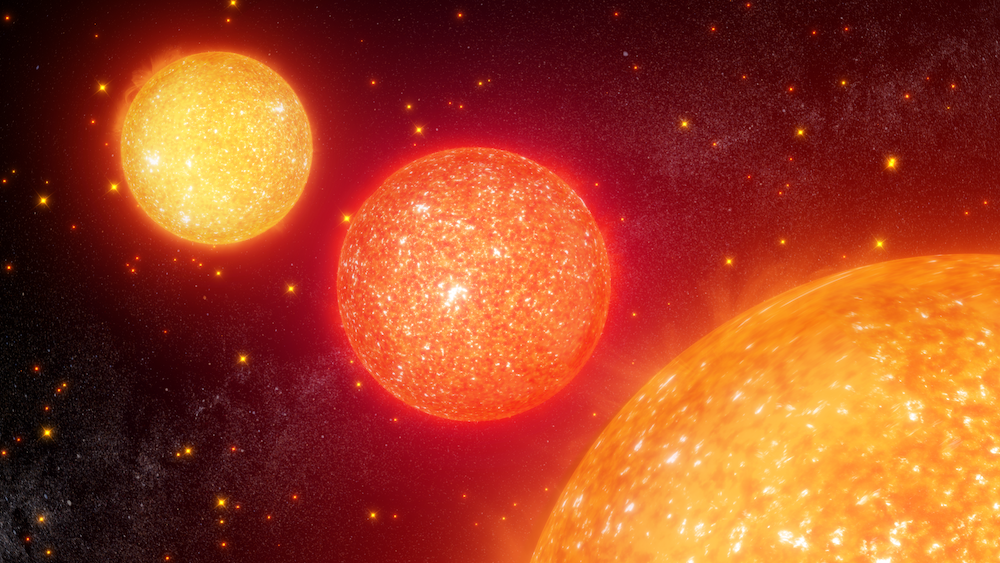Scientists get gruesome look at how stars like our sun eat their own planets

Scientists have known for years that one day, the sun will expand into a red giant and engulf its closest planets. A new study now explores how these devoured planets can influence the processes inside the dying star.
When stars the size of the sun run out of hydrogen in their cores, they balloon into red giants that may be more than ten times larger than the original star. As these red giants engulf the planets that orbit them, all sorts of things can happen.
Engulfing large planets, defined as 10 or more times the size of Jupiter, can trigger the star into shedding its envelope and increasing its brightness by several orders of magnitude for several thousands of years, the new study claims.
Related: Scientists spot elusive mini red giant stars, victims of stellar stealing
The study was conducted using a method called hydrodynamical simulations, and provides a glimpse into the possible future scenarios of our own solar system's evolution. Because of the size of red giant stars, the researchers had to model only a small section of the boundary where the stars meet the planets to gain in-depth insights into the interactions.
"Evolved stars can be hundreds or even thousands of times larger than their planets, and this disparity of scales makes it difficult to perform simulations that accurately model the physical processes occurring at each scale," Ricardo Yarza, a graduate astronomy student at the University of California, Santa Cruz, and lead author of the study, said in a statement. "Instead, we simulate a small section of the star centered on the planet to understand the flow around the planet and measure the drag forces acting on it."
The results may not only provide a glimpse into what will happen 5 billion years from now when our sun turns into a red giant, but also explain recent findings of planets orbiting white dwarfs, the burned-out stellar corpses into which stars turn after the red giant phase.
Get the Space.com Newsletter
Breaking space news, the latest updates on rocket launches, skywatching events and more!
These studies, exploring the end stages of this planetary engulfment, suggest that some planets may survive being burnt by the red giants.
In our solar system, the closest planets to the sun, Mercury and Venus, are expected to get swallowed by the growing sun entirely. Earth, while it may survive, will be so scorched that it will become completely uninhabitable. Some of the more distant and currently freezing cold bodies, such as Jupiter, Saturn and their moons, may develop more life-friendly conditions in the vicinity of the blown-up sun.
While only a few planets that have likely survived a red giant engulfment have been observed so far, researchers believe that further studies of exoplanets will lead to more such discoveries.
"We believe [planetary engulfment] is relatively common," Yarza said.
The study was accepted for publication in the Astrophysical Journal and is available in the online repository arxiv.
Follow Tereza Pultarova on Twitter @TerezaPultarova. Follow us on Twitter @Spacedotcom and on Facebook.
Join our Space Forums to keep talking space on the latest missions, night sky and more! And if you have a news tip, correction or comment, let us know at: community@space.com.

Tereza is a London-based science and technology journalist, aspiring fiction writer and amateur gymnast. Originally from Prague, the Czech Republic, she spent the first seven years of her career working as a reporter, script-writer and presenter for various TV programmes of the Czech Public Service Television. She later took a career break to pursue further education and added a Master's in Science from the International Space University, France, to her Bachelor's in Journalism and Master's in Cultural Anthropology from Prague's Charles University. She worked as a reporter at the Engineering and Technology magazine, freelanced for a range of publications including Live Science, Space.com, Professional Engineering, Via Satellite and Space News and served as a maternity cover science editor at the European Space Agency.









